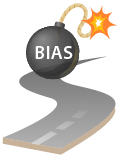
Today the megaproject bidding is a rampage of unrestrained biases. They make miracles – hush negative outcomes, find stunning similarity between the new data and the old one, rewrite universal laws on the premise of the project uniqueness, and hyper-inflate favorable outcomes. They are well studied and documented by Prof. Bent Flyvbjerg, the latest overview being given here.
The question is how to counteract these behavioral biases?
Conventional Project Management suggests Bid/No-Bid analysis. I discussed its pros and cons in my article of the same name. Being qualitative and subjective in nature, it too fell prey to mentioned biases.
Digitization opens a door to a new area of the answers search – volumes of data produced by layer-by-layer scanning of business around-the-clock. Crenger.com is an example. This data is a solid foundation for Expert System (ES) development. ES is generally defined as a computer application that performs a task that would otherwise be performed by a human expert.
What does a human expert specifically do in megaprojects?
Only two tasks. First is information mining and summarizing it in the form of recommendations, guidelines, and norms. The second is more dangerous – whistle blowing if something goes awry. All known ES building attempts target the first task. Megaprojects need the second.
The early warning expert system (EWS) shall signal to the management on the potential problems that is likely to surface during the megaproject execution. EWS shall be activated before bidding to keep at bay behavioral biases eroding the project success chances. Unlike human expert, EWS is 100% available and unbiased, and it may have an authority to decline the participation in the project bidding. EWS is a starting point for risk assessment and modeling and a force pushing the company out of its comfort zone. Therefore any EWS shall feature perpetual extension and transformation.
The EWS prototype developed by crenger.com uses a set of the project health indicators. Depending on the deviation from the normal range, they may trigger different alarms. Their priority is classified by 4 levels from "acceptable" to "code red".
Currently the health indicators address five areas – project complexity, engineering and design maturity, project team expertise, business conformity to project, and procurement conformity to project.
Project complexity
This broad category covers the customer input data validation and the desired output feasibility giving available commercial products and engineering services. Validation addresses not only seawater analysis and the quality of the final product, but the construction plot size. High construction density substantially increases the risk of safety accidents, design misses and delays in execution. Bespoke equipment like pumps with long lead time and special tests or items with high vibration risk makes project more difficult to execute. Even grass-root desalination process may have different levels of complexity. Example is requested level of operational flexibility which may vary from stable load to off-peak production.
Design & engineering maturity
Project engineering is essentially copy-paste-modify process. The scope and success of design modification depends upon two factors. First -design repeatability and modularity - relates to a number of design prototypes - projects executed in the past. The second factor is how far the new operation conditions deviate from the prototype's ones. Criticality of this point may be illustrated by the following existing practice in procurement of high-capacity pumps. If the vendor does not have the reference with the same materials or its production deviates by more than 20%, it is not qualified for bidding. This category also includes so-called delayed designs - optional and functional supply and pending groups - clear indicators of decision uncertainty. The most risk-associated indicator is design novelty, which may be labeled as copy, typical, prototype, commercially unproven, and pilot scale-up. Comparing to "copy" all others add uncertainty to the project budget and schedule with the upper bounds reaching over 200%.
Project team expertise
The first trivial indicator is design update count. Higher values show uncertainty in decision making, bearing in mind that crenger.com auto-generates the default design (!) at any stage. The second indicator tries to match the designer past experience – digital resume auto-generated by crenger.com - with new project. Arguably the most unusual indicator is the one related to proficiency in reusability of the previous project parts. It tracks how many times the designer just copies the same drawings like Process & Instrumentation Diagram (P&ID), and subsystems from previous projects. The quality of P&ID is also under scrutiny – the P&ID information density is analyzed as well.
Business conformity to project
The first indicator deals with the company ability to collaborate, to build contractor-subcontractor connections. It analyses outsourcing scope in terms of the extra load on the project team on the one hand, and the subcontractor references on the other hand. The second indicator analyses required business scale-up to execute the project.
Procurement conformity to project
This category is represented by only one indicator assessing procurement sources sufficiency. I discussed this problem in "Supplier Relationship Management" article. Alarm is raised if the number of prequalified bidders is less than 3 for any procured item.
